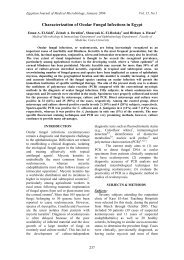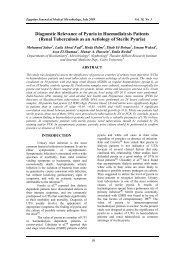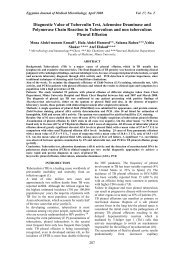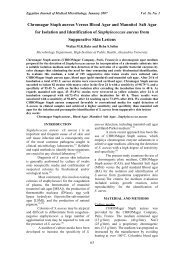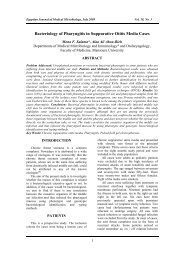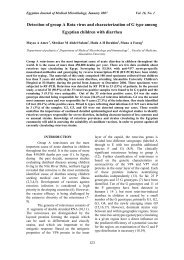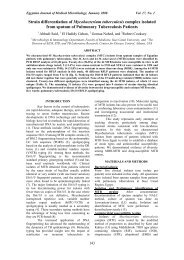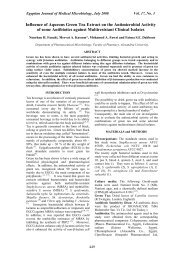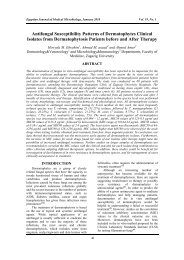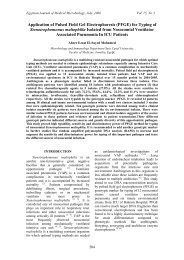Evaluation of the Antimicrobial and Cytotoxic Activity of Epiphany ...
Evaluation of the Antimicrobial and Cytotoxic Activity of Epiphany ...
Evaluation of the Antimicrobial and Cytotoxic Activity of Epiphany ...
You also want an ePaper? Increase the reach of your titles
YUMPU automatically turns print PDFs into web optimized ePapers that Google loves.
Egyptian Journal <strong>of</strong> Medical Microbiology, January 2007 Vol. 16, No. 1<br />
The results <strong>of</strong> cytotoxic effect<br />
evaluation <strong>of</strong> <strong>the</strong> examined sealers on<br />
fibroblast cells are shown in Table 2 <strong>and</strong><br />
Figure 5. Although every material tested<br />
showed some degree <strong>of</strong> toxicity, <strong>the</strong><br />
percentage <strong>of</strong> cell viability was greater with<br />
<strong>Epiphany</strong>, EndoFill <strong>and</strong> Apexit than with<br />
o<strong>the</strong>r sealers with no statistically significant<br />
difference between <strong>the</strong>se three sealers in both<br />
time periods (fresh <strong>and</strong> 24 h). O<strong>the</strong>r materials<br />
(Ketac-Endo, AH-26) showed significantly<br />
lower percentage <strong>of</strong> cell viability. All sealers<br />
showed increased number <strong>of</strong> viable cells after<br />
24 h.<br />
DISCUSSION<br />
A number <strong>of</strong> approaches have been<br />
used to evaluate <strong>the</strong> antimicrobial<br />
effectiveness in <strong>the</strong> laboratory. These include;<br />
incubation <strong>of</strong> broth cultures <strong>of</strong> <strong>the</strong> selected<br />
microorganisms with <strong>the</strong> agent under <strong>the</strong> test,<br />
growth <strong>of</strong> <strong>the</strong> selected microorganisms as<br />
lawns on agar surfaces using <strong>the</strong> disc<br />
diffusion method, <strong>and</strong> <strong>the</strong> artificial infection<br />
<strong>of</strong> extracted teeth with <strong>the</strong> selected organisms<br />
<strong>and</strong> irrigation with <strong>the</strong> test agent 21 .<br />
The agar diffusion method used in<br />
this study is one <strong>of</strong> <strong>the</strong> most <strong>of</strong>ten used<br />
methods for <strong>the</strong> antimicrobial activity<br />
assessment. The results <strong>of</strong> this method do not<br />
depend only on <strong>the</strong> toxicity <strong>of</strong> <strong>the</strong> material for<br />
a particular microorganism, but also on <strong>the</strong><br />
diffusibility <strong>of</strong> <strong>the</strong> material across <strong>the</strong><br />
medium. However, great care has been taken<br />
in this study to keep <strong>the</strong> plates for 2h at room<br />
temperature to allow <strong>the</strong> diffusion <strong>of</strong> <strong>the</strong><br />
agent through <strong>the</strong> agar <strong>and</strong> <strong>the</strong>n incubated at<br />
37ºC under appropriate gaseous conditions.<br />
The present study tested <strong>the</strong> antimicrobial<br />
activity <strong>of</strong> different sealers against<br />
microorganisms considered to be resistant to<br />
endodontic treatment. Therefore, if a sealer is<br />
effective against <strong>the</strong>se microorganisms, it will<br />
probably be effective against <strong>the</strong> most<br />
susceptible ones 22 .<br />
In this study, <strong>Epiphany</strong> produced a<br />
clear antibacterial effect against <strong>the</strong> tested<br />
bacteria especially <strong>the</strong> most resistant one<br />
(E.faecalis). On <strong>the</strong> contrary, Bodrumlu <strong>and</strong><br />
Semiz 23 showed that <strong>Epiphany</strong> root canal<br />
sealers had little effect on E.faecalis 23 . This<br />
can be explained by a research conducted by<br />
Gomes et al. 5 , who determined that <strong>the</strong><br />
antimicrobial activity depends on <strong>the</strong><br />
sensitivity <strong>of</strong> <strong>the</strong> drug, bacterial source (wild<br />
strains or collection species), number <strong>of</strong><br />
bacteria inoculated, pH <strong>of</strong> <strong>the</strong> substrates in<br />
plates or tubes, agar viscosity, storage<br />
conditions <strong>of</strong> <strong>the</strong> agar plates, incubation time<br />
<strong>and</strong> <strong>the</strong> metabolic activity <strong>of</strong> <strong>the</strong><br />
microorganisms.<br />
The results <strong>of</strong> this study showed<br />
that <strong>Epiphany</strong> had no effect on C.albicans.<br />
Moderate inhibition was produced by<br />
<strong>Epiphany</strong> on E.coli <strong>and</strong> S. aureus isolates.<br />
EndoFill had <strong>the</strong> maximum average<br />
zones <strong>of</strong> inhibition as compared to o<strong>the</strong>r<br />
tested sealers. However, it comes next to<br />
<strong>Epiphany</strong> regarding <strong>the</strong> effect against<br />
E.faecalis. On <strong>the</strong> o<strong>the</strong>r h<strong>and</strong>, this material<br />
was <strong>the</strong> only effective sealer on C.albican.<br />
Previous studies indicated that root canal<br />
sealers containing ZOE have a strong<br />
antibacterial effect 24 . This effect was due to<br />
<strong>the</strong> action <strong>of</strong> eugenol 25 . Kaplan <strong>and</strong> o<strong>the</strong>rs<br />
have stated that <strong>the</strong> most effective<br />
antimicrobial sealers contain eugenol <strong>and</strong><br />
formaldehyde 26 .<br />
O<strong>the</strong>r endodontic sealers tested<br />
(Apexit, AH-26 <strong>and</strong> Ketac-Endo) were less<br />
effective than <strong>Epiphany</strong> in killing <strong>the</strong><br />
microorganisms. The antimicrobial activity <strong>of</strong><br />
Apexit may be based on its content <strong>of</strong> calcium<br />
hydroxide. Root canal sealers integrated with<br />
calcium hydroxide have enhanced<br />
antimicrobial activity 23, 27. The<br />
antimicrobial effect <strong>of</strong> this sealer is produced<br />
by <strong>the</strong> release <strong>of</strong> hydroxyl ions which<br />
increases <strong>the</strong> pH above 12.5 23. In this<br />
experiment Apexit had <strong>the</strong> lowest average<br />
diameter <strong>of</strong> inhibition zones. Bystrom <strong>and</strong><br />
Sundqvist 28 also found that for a calcium<br />
hydroxide based sealer to be an effective<br />
antimicrobial agent, it should maintain a pH<br />
level greater than 12.5. As <strong>the</strong> calcium<br />
hydroxide sealer sets, <strong>the</strong> pH declines rapidly<br />
to 9.4 causing loss <strong>of</strong> effectiveness.<br />
Some endodontic sealers consists <strong>of</strong><br />
polymer materials such as AH-26 which<br />
release small amount <strong>of</strong> formaldehyde during<br />
<strong>the</strong> polymerization process, <strong>and</strong> it is this agent<br />
that gives <strong>the</strong> resin based sealer its<br />
antimicrobial effect 29. Bodrumlu <strong>and</strong> Semiz<br />
23 showed that AH-26 had <strong>the</strong> lowest<br />
antibacterial effect against E.faecalis, <strong>and</strong><br />
attributed this effect to <strong>the</strong> release <strong>of</strong> a small<br />
amount <strong>of</strong> formaldehyde over a brief period<br />
<strong>of</strong> time. In this study AH-26 had a minor<br />
effect against <strong>the</strong> tested organisms <strong>and</strong> in<br />
100



